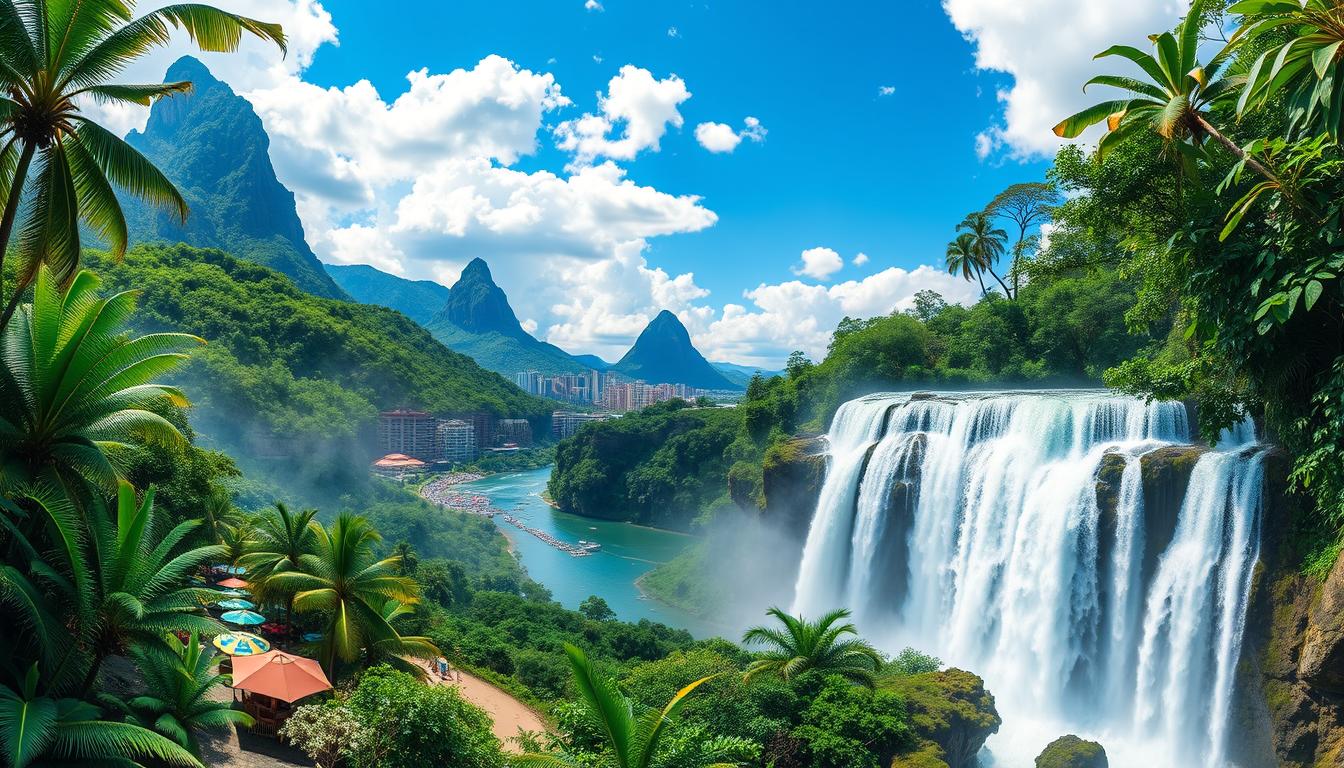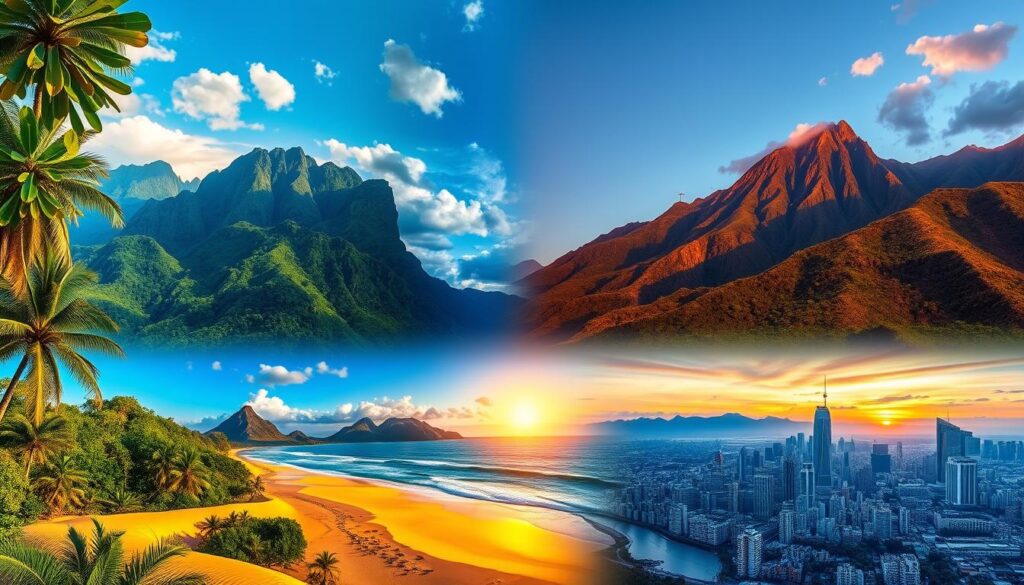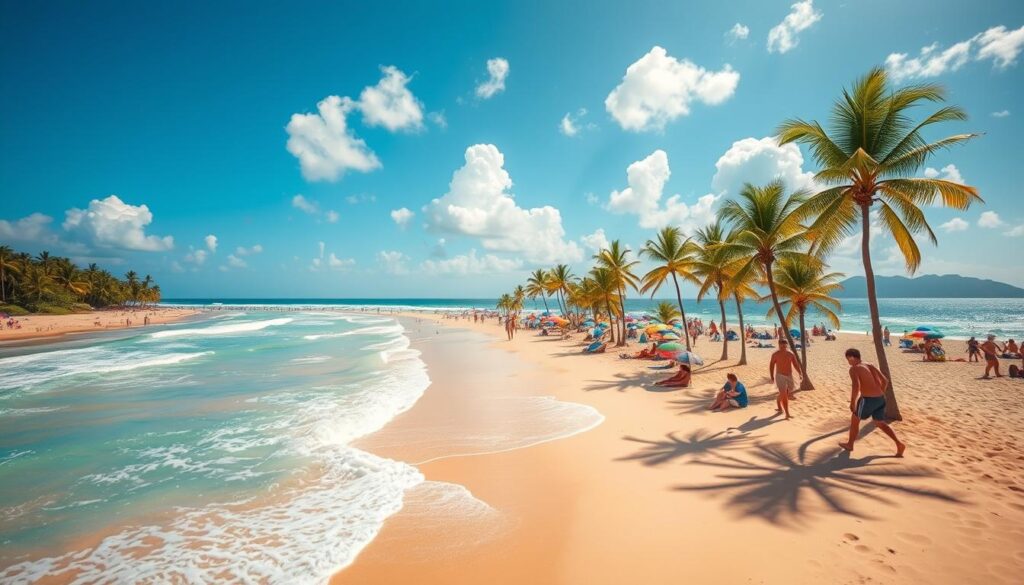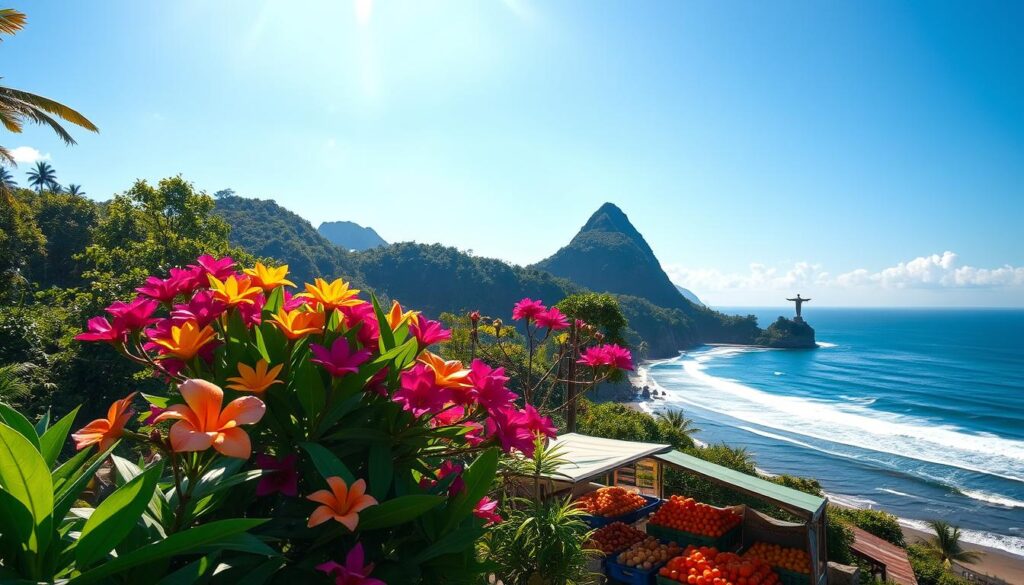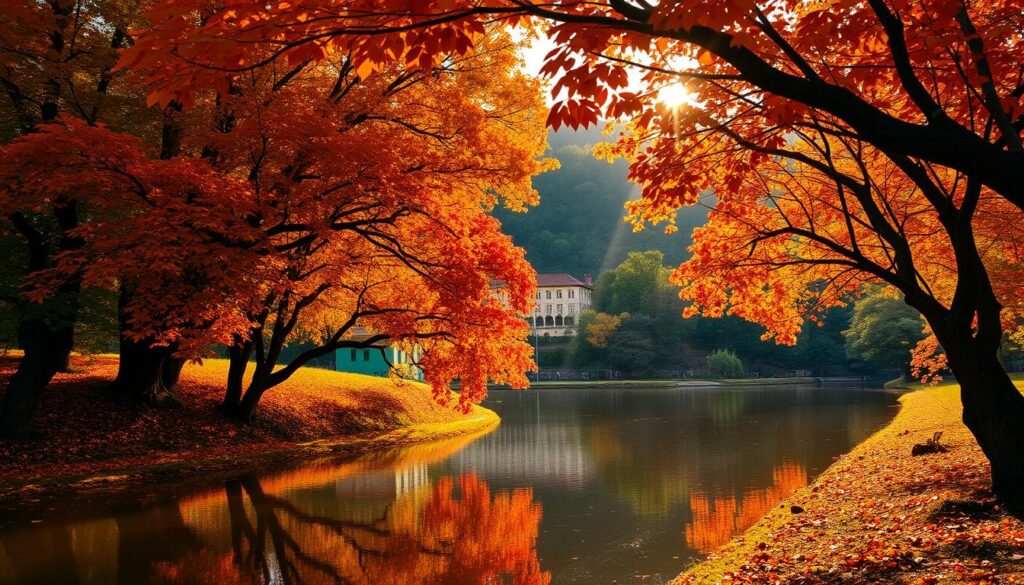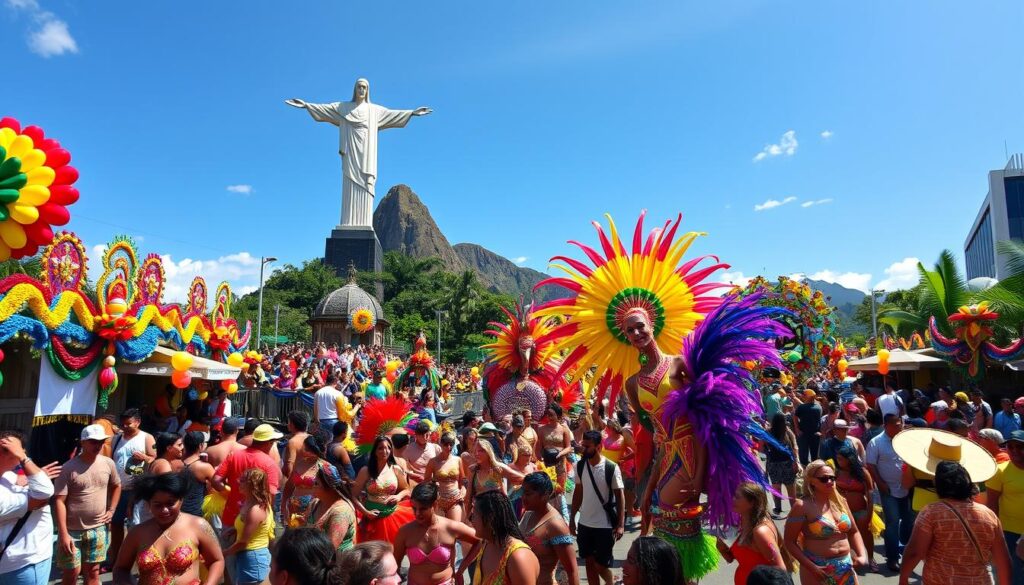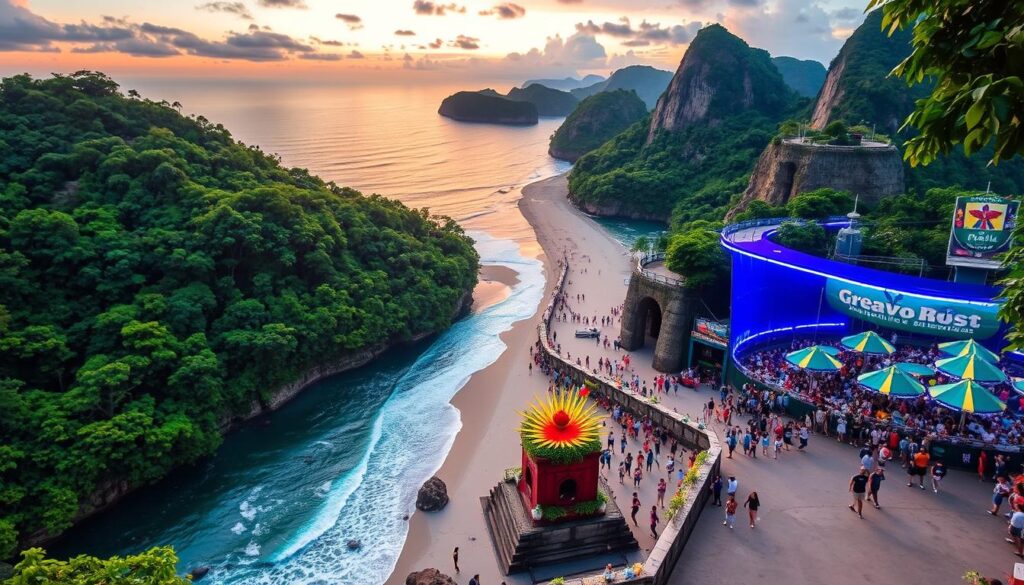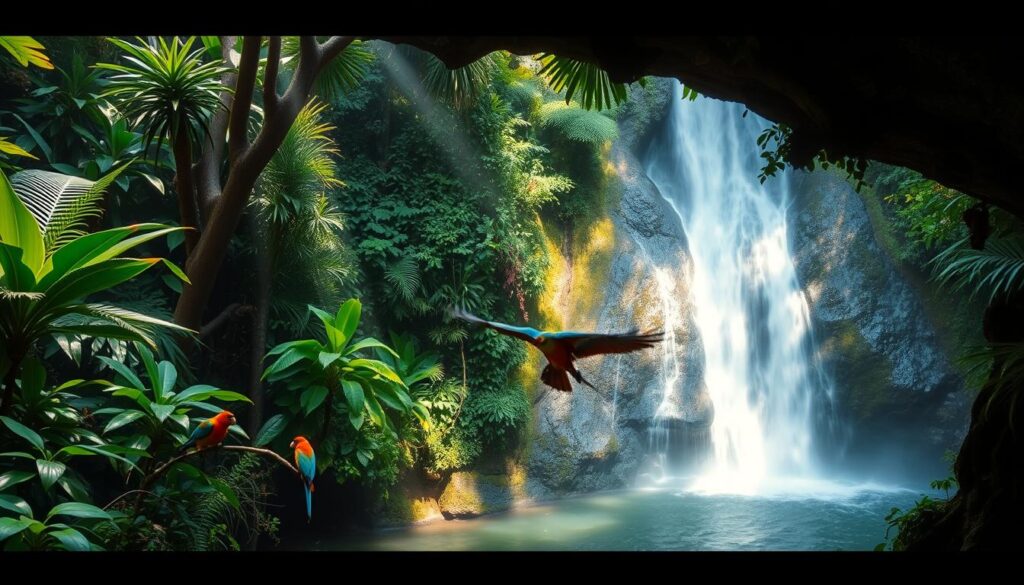Determining the best time to visit Brazil is crucial for an unforgettable trip. Brazil offers diverse landscapes, from the Amazon rainforest to Rio’s sunny beaches. The best time to visit depends on your destination and interests. Brazil’s climate varies greatly, with seasons ranging from tropical to subtropical.
Summer in Brazil lasts from December to March. Winter runs from June to September. The shoulder season, September to November, is ideal for most travelers.
This period boasts mild weather and fewer tourists. It’s perfect for exploring Brazil’s natural wonders and vibrant cities.
Temperature in Brazil varies by region and season. Rio’s spring temperatures reach 27°C (80°F) during the day. They drop to 21°C (70°F) at night. The Amazon can hit 33°C (91°F) in the same season.
Knowing Brazil’s monthly weather is key for trip planning. Each region has unique climate patterns. The northern coast offers year-round warmth for beach lovers. The south experiences more distinct seasonal changes.
Key Takeaways
- Shoulder season (September-November) offers the best overall experience
- Brazil’s climate varies from tropical to subtropical across regions
- Summer (December-March) is hot and humid, winter (June-September) is milder
- Northern coast has year-round warm temperatures for beach holidays
- Amazon and Pantanal have specific ideal visiting times based on rainfall patterns
Understanding Brazil’s Diverse Climate
Brazil’s climate is as diverse as its landscape. Each region offers unique weather conditions. These climate variations shape travel experiences and influence the best times to visit.
Tropical vs. Subtropical Regions
Northern Brazil has a tropical climate with year-round warmth. The south enjoys a subtropical climate with distinct seasons. This variety means ideal conditions exist somewhere in Brazil all year.
Seasonal Variations Across the Country
Temperature changes vary across Brazil’s regions. The Amazon stays hot year-round, with a wet season from December to May. Southern Brazil has cooler winters from June to August.
Coastal areas maintain warm temperatures throughout the year. These conditions are perfect for beach vacations anytime.
Impact of Climate on Travel Plans
The weather during your visit can greatly affect your experience. The Amazon’s dry season (June-November) is best for land exploration. Wildlife enthusiasts should visit the Pantanal from April to October.
Coastal areas are appealing year-round. I prefer slightly cooler months for comfortable sightseeing.
- North: Hot and humid year-round
- South: Mild winters, hot summers
- Coastal: Warm temperatures throughout the year
- Central: Very hot with occasional cool spells in winter
Knowing these climate patterns helps plan the perfect Brazilian adventure. It ensures you make the most of your visit to this beautiful country.
Summer in Brazil: December to March
Summer in Brazil bursts with vibrant energy from December to March. The country explodes with festivities and sun-soaked adventures. In Rio de Janeiro, temperatures soar into the 90s, kicking off the season.
Brazil’s summer officially starts in December and ends in March. This period attracts both local and international tourists. December brings Christmas celebrations and parties, setting the tone for the coming months.
Summer heat and humidity spread across the country. Rio’s average temperatures range from 75°F to 89°F. Salvador da Bahia enjoys similar warmth, with temperatures between 74°F and 89°F.
The beaches are crowded, the cities are buzzing, and the rainforests are lush. It’s Brazil at its most exuberant!
Summer brings prime beach weather, but rainfall increases in some areas. The Amazon sees daily cloudbursts from December to May. Coastal Northeast regions, like Fortaleza, experience heavy rain in February and March.
Despite occasional rain, summer remains a popular tourist season. It offers bustling beaches, vibrant festivals, and lush landscapes. Waterfall visits are perfect during this time.
- Bustling beaches
- Vibrant festivals
- Lush, green landscapes
- Perfect conditions for waterfall visits
Be aware that this is peak tourist season. Expect higher prices and larger crowds, especially in January and February. However, the electric atmosphere makes visiting Brazil unforgettable.
Winter Wonders: June to August
Brazil’s winter offers a pleasant surprise for travelers. From June to August, the country enjoys milder temperatures and clear skies. This season is perfect for outdoor adventures and wildlife spotting.
Mild Temperatures and Clear Skies
In popular spots like Rio de Janeiro, winter temperatures rarely dip below 68°F. July is typically dry, making it great for exploring cities and natural wonders. June sees less rainfall, especially along the northeastern coast.
Ideal for Outdoor Adventures
Winter’s comfortable temperatures and smaller crowds make outdoor activities more enjoyable. It’s a great time for hiking in national parks or exploring the Amazon. The Pantanal wetlands offer unique wildlife viewing during this dry season.
Whale Watching Opportunities
June marks the start of whale watching season along Brazil’s southern coast. You can spot majestic humpback whales migrating to warmer waters. This spectacle continues through August, delighting nature lovers.
- Average rainfall: 2-5 days per month
- Temperature range: 64°F to 77°F
- Popular activities: Wildlife spotting, hiking, city tours
Brazil’s winter blends mild weather with exciting experiences. You can explore vibrant cities or immerse yourself in nature. This season sets the stage for unforgettable adventures across the country.
Spring Splendor: September to November
Spring in Brazil brings mild weather and fewer crowds. I found September particularly enchanting. The weather ranges from pleasant to warm, perfect for outdoor adventures.
I explored Rio’s lush jungles, which reach the ocean. The beaches were less crowded than in peak season. This allowed for a more relaxed experience.
Brazil’s November weather remains favorable. Temperatures typically range from 70°F to 80°F (21°C to 27°C).
Spring is great for visiting lesser-known gems like Ilha Grande. This car-free island offers pristine beaches and hiking trails. I paid $5 for a luggage porter at the main pier.
- Ideal for outdoor activities
- Lower prices on accommodations
- Perfect for exploring Brazil’s diverse landscapes
November is perfect for exploring the Amazon during its “dry season”. It’s great for wildlife spotting and hiking through the world’s largest rainforest.
Spring in Brazil is a hidden gem for travelers seeking the perfect balance of good weather and smaller crowds.
Spring offers an ideal climate for experiencing Brazil’s diverse attractions. You can enjoy vibrant city life or seek out serene natural wonders.
Autumn Adventures: March to May
Brazil’s autumn is a magical time for exploration. March kicks off this season with cooler temperatures. It’s perfect for outdoor activities and sightseeing without summer crowds.
May marks the end of autumn in Brazil. It’s your last chance to enjoy mild weather before winter arrives.
Pleasant Weather for Exploration
March in Brazil brings warm, inviting weather. Rio de Janeiro’s temperatures hover around 80°F (27°C), ideal for city tours and beach visits.
As autumn progresses, rainfall decreases. This makes it an excellent time for sightseeing and outdoor adventures.
Fall Foliage in Southern Brazil
Southern Brazil offers a unique autumn experience. In Rio Grande do Sul, trees turn shades of gold and red.
This creates picturesque landscapes that are captivating and often overlooked. It’s a hidden gem of Brazilian autumn.
Wine Harvest in Serra Gaúcha
May in Brazil is a treat for wine lovers. The Serra Gaúcha region celebrates its annual wine harvest.
You can participate in grape stomping events and wine tastings. It’s a fantastic way to experience Brazil’s growing wine industry.
Autumn in Brazil blends pleasant weather with unique experiences. You can explore cities, admire fall foliage, or indulge in wine country.
March to May is an excellent time to visit this diverse country. You’ll find a perfect mix of activities and comfortable temperatures.
Best Time to Visit Brazil for Festivals and Events
Brazil’s vibrant culture shines through its many festivals. The best time to visit is from December to March. This period hosts major holidays and events, making it exciting for travelers.
Carnival is the highlight of Brazil’s festival calendar. This world-famous celebration happens in February or early March, before Ash Wednesday. Cities across Brazil burst with music, dance, and colorful parades.
Rio New Years is another must-see event. On December 31st, Copacabana Beach becomes a massive party venue. Millions gather to watch fireworks and join unique traditions.
One tradition involves jumping over seven waves at midnight. People believe this brings good luck for the coming year.
- Carnival: February or early March
- Rio New Years: December 31st
- Oktoberfest: October
- Rock in Rio: September (alternating years)
October brings Oktoberfest to many Brazilian cities. This festival shows Brazil’s unique mix of European and South American traditions. In September, music fans enjoy Rock in Rio, a huge music festival.
Remember, prices for hotels and flights rise during these popular events. If you want to experience a Brazil holiday today, book early. This will help you get the best deals.
Regional Highlights and When to Visit
Brazil’s diverse regions offer unique experiences year-round. The best times to visit key destinations depend on weather patterns and special events. Let’s explore the ideal times for different areas.
Amazon Rainforest
The Amazon has dry and wet seasons. June to November is dry, perfect for land exploration. December to May brings heavy rains, ideal for canoe trips through flooded forests.
Temperatures stay around 88°F all year. Pack light clothes and rain gear for your Amazon adventure.
Rio de Janeiro
Rio is great to visit any time of year. Summer, from December to March, is the best time. Temperatures range between 77-86°F during these months.
February or early March hosts the famous Carnival. It draws huge crowds. For a quieter visit, try September or October.
Pantanal
Wildlife fans should visit the Pantanal from April to October. This dry season offers the best chances to see animals. Temperatures range from 86-95°F, with little rain.
It’s the perfect time to spot jaguars, especially in September and October. The dry weather makes wildlife viewing easier.
Brazil’s rainy season varies by region. Check local climate patterns when planning your trip. This will help you make the most of your Brazilian adventure.
Hidden Gems and Off-Season Travel
Brazil has amazing hidden gems perfect for off-season travel. These spots offer unique experiences without crowds. They’re ideal for exploring Brazil off the beaten path.
Lençóis Maranhenses National Park is a top off-season destination in Brazil. In July, this desert transforms into a wonderland of rainwater lagoons. The sight is truly breathtaking.
History lovers should visit Ouro Preto in Minas Gerais. Cooler months offer comfortable temperatures for exploring. Its colonial architecture and rich cultural heritage are worth seeing.
- Fernando de Noronha archipelago: Excellent for diving and beaches year-round
- Jalapão State Park: Adventure opportunities in a less-visited region
- São Paulo Guarulhos International Airport: Gateway to many hidden gems
Off-season travel in Brazil offers better rates and authentic experiences. You’ll have fewer tourists around you. This allows for deeper immersion in local culture and Brazilian hospitality.
“Traveling off-season allowed me to see a side of Brazil I never knew existed. It was like having the country’s beauty all to myself.”
Brazil’s peak season is from December to March/April. Planning outside these months can lead to savings. You’ll also enjoy unique experiences.
Get ready to explore Brazil’s hidden treasures. Pack your bags and discover the diversity of this amazing country!
Conclusion
Brazil’s diverse climate affects the best time to visit. The shoulder seasons offer pleasant weather and fewer crowds. These run from April to June and September to November.
Summer, from December to March, is ideal for beach lovers. However, it brings higher prices and larger crowds. Winter, from June to August, is perfect for wildlife enthusiasts.
Regional highlights play a crucial role in planning. The Amazon’s dry season, from May to September, is best for wildlife spotting. Rio’s beaches are liveliest during summer months.
Brazil offers unique experiences year-round. You can enjoy Carnaval in Rio or explore serene northeastern beaches. The Amazon’s breathtaking landscapes are also a must-see attraction.
Align your travel dates with your preferred activities and destinations. This approach ensures an unforgettable Brazilian adventure. Your choices will shape your experience in this diverse country.
FAQ
What is the best time to visit Brazil?
Brazil’s shoulder seasons offer the best visiting experience. These run from September to November and April to June. You’ll enjoy mild weather, fewer tourists, and lower prices during these times.
The ideal time may vary based on your interests. Different destinations within Brazil have unique optimal visiting periods.
What is the climate like in different regions of Brazil?
Brazil’s climate varies greatly from north to south. The north is tropical, while the south is subtropical. The Amazon has high temperatures year-round.
Its wet season lasts from December to May. Southern Brazil experiences more distinct seasons. These regional differences affect the best times for activities.
What is the weather like during the Brazilian summer (December-March)?
Brazilian summers are hot and humid. In Rio de Janeiro, temperatures can reach 87°F (31°C). Iguazu Falls can see temperatures up to 89°F (32°C).
This season is popular for beach activities and events like Carnival. However, it’s also the busiest tourist season with higher prices.
Is winter a good time to visit Brazil?
Brazilian winters (June-August) offer mild temperatures. In Rio de Janeiro, it rarely drops below 68°F (20°C). This season brings clear skies and less rainfall.
It’s ideal for outdoor activities and city exploration. Winter is also great for wildlife spotting in the Pantanal and Amazon visits.
What are the advantages of visiting Brazil during the spring (September-November)?
Spring in Brazil is a shoulder season. It offers mild, mostly dry weather. In Rio de Janeiro, temperatures range from 70°F to 80°F (21°C to 27°C).
This period is perfect for exploring outdoor attractions. You’ll encounter fewer crowds and enjoy lower prices.
What makes autumn (March-May) a good time to visit Brazil?
Autumn brings warm temperatures and less rain to Brazil. It’s ideal for city exploration and cultural trips. You can witness unique events like fall foliage in southern Brazil.
The wine harvest in Serra Gaúcha is another autumn highlight.
When are the major festivals and events held in Brazil?
Carnival, Brazil’s most famous festival, usually happens in February or March. Rio’s New Year’s Eve features spectacular fireworks on Copacabana Beach.
Various cultural and music festivals occur year-round. Many of these are concentrated in the summer months (December-March).
What are the best times to visit specific regions in Brazil?
The Amazon Rainforest is best visited during the dry season (June-November). The Pantanal is ideal for wildlife viewing from April to October.
Coastal areas like Florianópolis are excellent from October to April. Rio de Janeiro is popular year-round, especially during Carnival.
Are there any hidden gems or off-season destinations worth visiting in Brazil?
Off-season travel offers unique experiences with fewer crowds. Visit Lençóis Maranhenses National Park in July or Ouro Preto in cooler months.
The Fernando de Noronha archipelago is great during shoulder seasons. Jalapão State Park in Tocantins is another hidden gem.
Off-peak travel often means better rates and more authentic experiences.


